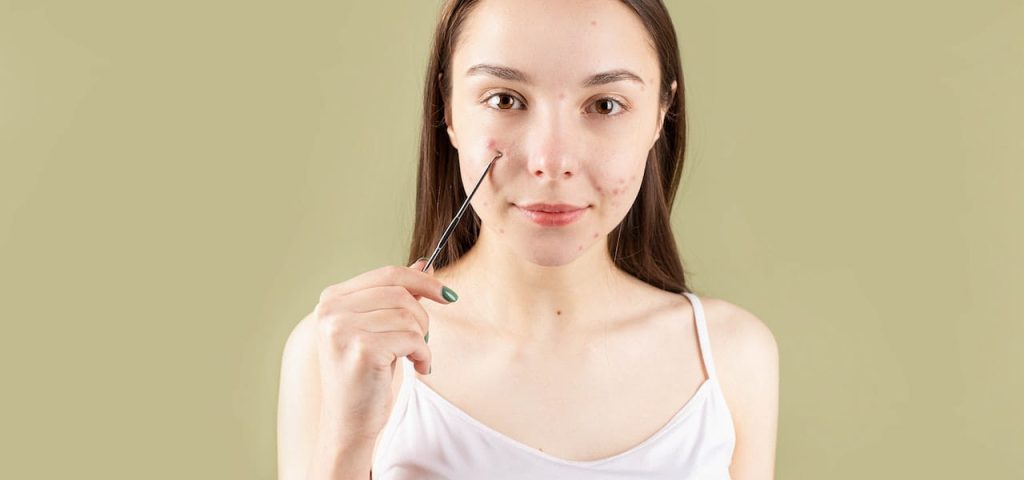Here is your complete guide to pimples vs cold sores.
Introduction to Pimples vs Cold Sores
Both pimples and cold sores are skin conditions that can affect the face, but they are caused by different factors and require different treatments. In this blog post, we will compare pimples and cold sores, as well as their causes, symptoms, and treatment options. Here is your complete Guide To pimples vs cold sores.
Pimples vs Cold Sores
Causes:
Clogged pores, which can be caused by excess oil production, dead skin cells, and bacteria, cause pimples. Hormonal changes, stress, and certain medications can also set them off. The herpes simplex virus, on the other hand, causes cold sores (HSV). HSV comes in two varieties: type 1, which is associated with cold sores, and type 2, which is associated with genital herpes. HSV is highly contagious and can be spread through kissing, oral sex, or sharing utensils or lip balm with an infected person.
Read More About What Is Balayage.
Symptoms: Pimples vs Cold Sores
Pimples typically appear on the face as red bumps or whiteheads, particularly around the nose, chin, and forehead. Other symptoms that may accompany them, such as:
- Tenderness or pain in the affected area.
- Swelling or inflammation in the vicinity of the affected area.
- A pus-filled center that has the potential to rupture and release its contents.
Cold sores, on the other hand, typically manifest as small, fluid-filled blisters on or near the lips, though they can also appear on the nose or chin. Other symptoms will accompany them include:
- Before the blisters appear, there may be tingling or itching in the affected area.
- Swelling and redness in the vicinity of the affected area.
- Pain or discomfort in the vicinity of the affected area.
- As the blisters begin to heal, they crunch over.
Read More About How To Apply Eye Cream.
Treatment: Pimples vs Cold Sores
The treatment options for pimples and cold sores vary depending on the underlying cause. Treatment options for pimples may include:
- Topical treatments, such as benzoyl peroxide, salicylic acid, or retinoids, can help unclog pores and reduce inflammation.
- Prescription medications: A doctor may prescribe topical or oral antibiotics to help clear up acne in some cases.
- Avoiding triggers such as oily or greasy foods, stress, and certain medications may help to prevent pimple formation.
Read More About How Curl Hair Flat Iron?
Treatment options for cold sores may include:
- Antiviral creams, such as acyclovir or docosanol, are available over-the-counter (OTC) and can help reduce the duration and severity of cold sores.
- Prescription medications: A doctor may prescribe antiviral medications such as valacyclovir or famciclovir to help manage the symptoms of cold sores in some cases.
- Applying a cold, damp cloth to the affected area can help relieve pain and swelling.
- Pain relievers such as ibuprofen or acetaminophen can help reduce the pain and discomfort associated with cold sores.
Prevention: Pimples vs Cold Sores
Different methods are used to prevent pimples and cold sores. You can avoid pimples by doing the following:
- Wash your face twice a day with a gentle cleanser and avoid touching your face with dirty hands.
- Picking or squeezing pimples can lead to further inflammation and scarring.
- Use non-comedogenic products: Look for skin care and makeup products that are non-comedogenic, which means they will not clog your pores.
- Eat a healthy diet: A diet high in fruits, vegetables, and lean protein can help keep your skin in good condition.

Pimples
They are a very common skin condition that affects millions of people all over the world. They are a type of acne that occurs when oil and dead skin cells clog hair follicles. We will look at the causes, symptoms, and treatment options for pimples in this blog post.
Causes: Pimples vs Cold Sores
Excess oil production, dead skin cells, and bacteria are all factors that contribute to pimples. The following are some common factors that can contribute to the development of pimples:
- Hormonal changes: Hormonal changes during puberty, menstrual cycles, and pregnancy can increase oil production, leading to pimples.
- Genetics: Pimples can run in families, suggesting that genetics play a role in their development.
- Poor skincare: Failing to cleanse your skin properly or using harsh products can contribute to the development of pimples.
- Diet: Consuming a diet high in sugar and refined carbohydrates can increase insulin levels, which can lead to increased oil production and the development of pimples.
Symptoms: Pimples vs Cold Sores
Pimples typically appear as small, red bumps on the skin. Other symptoms that may accompany them, such as:
- Whiteheads: Small, raised bumps that are white or yellow in color.
- Blackheads are small, raised bumps of black or dark color.
- Papules: Small, raised bumps that are red also tender to the touch.
- Pustules: Small, raised bumps that are filled with pus.
Pimples can occur anywhere on the body, but are most commonly found on the face, neck, back, and chest.
Treatment:
There are several treatment options available for pimples, including over-the-counter (OTC) creams, prescription medications, and lifestyle changes. These include:
- OTC creams: These may include topical treatments like benzoyl peroxide, salicylic acid, or retinoids, which can help reduce inflammation and unclog pores.
- Prescription medications: In some cases, a doctor may prescribe antibiotics or oral contraceptives to help manage the symptoms of pimples.
- Lifestyle changes: Simple lifestyle changes like eating a healthy diet, drinking plenty of water, and avoiding touching your face can help reduce the frequency and severity of pimples.
- Professional treatments: Dermatologists may offer professional treatments like chemical peels, microdermabrasion, or laser therapy to help manage severe cases of pimples.
Prevention:
Preventing pimples involves taking steps to reduce oil production and prevent the buildup of dead skin cells. Some tips for preventing pimples include:
- Use a gentle cleanser to wash your face twice per day.
- Don’t touch your face or pick at pimples.
- Use non-comedogenic skincare products that won’t clog pores.
- Avoid wearing tight-fitting clothing or equipment that can cause friction against the skin.
- Relaxation techniques such as meditation or yoga can help you reduce stress.
Cold Sores
Cold sores, also known as fever blisters, are a widespread viral infection that affects millions of people around the world. They are caused by the herpes simplex virus (HSV), which is highly contagious and can be transmitted by kissing, oral sex, or sharing utensils or lip balm with an infected person. We will look at the causes, symptoms, and treatment options for cold sores in this blog post.
Causes:
The herpes simplex virus causes cold sores, which can be contracted through close contact with an infected person. Once inside the body, the virus can lay dormant in nerve cells for months or even years before reactivating and causing an outbreak. The following triggers can cause the virus to reactivate and cause a cold sore outbreak:
- Illness or infection
- Hormonal changes
- Stress or fatigue
- Sun exposure
- Dental work or other mouth trauma
Symptoms:
Cold sores typically appear as small, fluid-filled blisters on or around the lips, but can also occur on the nose or chin.Other symptoms that may accompany them include:
- Tingling or itching around the affected area before the blisters appear.
- Swelling and redness around the affected area.
- Pain or discomfort around the affected area.
- Fever or headache in some cases.
As the blisters begin to heal, they may crust over and eventually scab before falling off. Cold sores usually last for 7-10 days, but can sometimes last longer.
Read More About How To Curl Hair?
Treatment:
While there is no cure for cold sores, there are several treatment options available to help manage symptoms and speed up the healing process. These include:
- Over-the-counter (OTC) creams: These may include antiviral creams like acyclovir or docosanol, which can help reduce the duration and severity of cold sores. They should be applied at the first sign of a cold sore outbreak for best results.
- Prescription medications: In some cases, a doctor may prescribe antiviral medications like valacyclovir or famciclovir to help manage the symptoms of cold sores. These medications can be taken orally or even applied topically.
- Cold compresses: Applying a cold, damp cloth to the affected area can help reduce pain and swelling.
- Pain relief: Over-the-counter pain relievers like ibuprofen or acetaminophen may help reduce pain and discomfort associated with cold sores.
Prevention:
Preventing cold sores involves taking steps to avoid contact with the herpes simplex virus. Some tips for preventing cold sores include:
- Avoid close contact with someone who has a cold sore outbreak.
- Wash your hands frequently, especially after coming into contact with someone who has a cold sore outbreak.
- Avoid sharing utensils, lip balm, or other personal items with someone who has a cold sore outbreak.
- Protect your skin from the sun with sunscreen or lip balm with SPF.
- Relaxation techniques such as meditation or yoga can help you manage stress.
Conclusion
Cold sores are a common viral infection caused by the herpes simplex virus. While there is no cure for cold sores, there are several treatment options available to help manage symptoms and speed up the healing process. By taking steps to prevent the spread of the virus, you can reduce your risk of developing cold sores in the future.
Pimples are a common skin condition caused by a number of factors such as excessive oil production, dead skin cells, and bacteria. While there are several treatment options available, the most effective way to manage pimples is to prevent them through simple lifestyle changes and proper skincare. You can reduce your risk of developing pimples in the future by taking steps to reduce oil production and prevent the buildup of dead skin cells.

